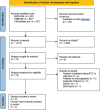Prothrombin complex concentrate (PCC) for treatment of trauma-induced coagulopathy: systematic review and meta-analyses
- PMID: 37919775
- PMCID: PMC10621181
- DOI: 10.1186/s13054-023-04688-z
Prothrombin complex concentrate (PCC) for treatment of trauma-induced coagulopathy: systematic review and meta-analyses
Abstract
Background: Trauma-induced coagulopathy (TIC) is common in trauma patients with major hemorrhage. Prothrombin complex concentrate (PCC) is used as a potential treatment for the correction of TIC, but the efficacy, timing, and evidence to support its use in injured patients with hemorrhage are unclear.
Methods: A systematic search of published studies was performed on MEDLINE and EMBASE databases using standardized search equations. Ongoing studies were identified using clinicaltrials.gov. Studies investigating the use of PCC to treat TIC (on its own or in combination with other treatments) in adult major trauma patients were included. Studies involving pediatric patients, studies of only traumatic brain injury (TBI), and studies involving only anticoagulated patients were excluded. Primary outcomes were in-hospital mortality and venous thromboembolism (VTE). Pooled effects of PCC use were reported using random-effects model meta-analyses. Risk of bias was assessed for each study, and we used the Grading of Recommendations Assessment, Development, and Evaluation to assess the quality of evidence.
Results: After removing duplicates, 1745 reports were screened and nine observational studies and one randomized controlled trial (RCT) were included, with a total of 1150 patients receiving PCC. Most studies used 4-factor-PCC with a dose of 20-30U/Kg. Among observational studies, co-interventions included whole blood (n = 1), fibrinogen concentrate (n = 2), or fresh frozen plasma (n = 4). Outcomes were inconsistently reported across studies with wide variation in both measurements and time points. The eight observational studies included reported mortality with a pooled odds ratio of 0.97 [95% CI 0.56-1.69], and five reported deep venous thrombosis (DVT) with a pooled OR of 0.83 [95% CI 0.44-1.57]. When pooling the observational studies and the RCT, the OR for mortality and DVT was 0.94 [95% CI 0.60-1.45] and 1.00 [95% CI 0.64-1.55] respectively.
Conclusions: Among published studies of TIC, PCCs did not significantly reduce mortality, nor did they increase the risk of VTE. However, the potential thrombotic risk remains a concern that should be addressed in future studies. Several RCTs are currently ongoing to further explore the efficacy and safety of PCC.
Keywords: Blood coagulation factors; Blood transfusion; Major trauma; Prothrombin complex concentrate; Trauma hemorrhage; Trauma-induced coagulopathy.
© 2023. The Author(s).
Conflict of interest statement
The authors declare no funding or conflicts of interest.
Figures
Comment in
-
Critical appraisal and concerns regarding a meta-analysis on prothrombin complex concentrate (PCC) for trauma-induced coagulopathy: unveiling methodological nuances and treatment variances.Crit Care. 2023 Nov 21;27(1):454. doi: 10.1186/s13054-023-04743-9. Crit Care. 2023. PMID: 37990329 Free PMC article. No abstract available.
References
Publication types
MeSH terms
Substances
LinkOut - more resources
Full Text Sources
Medical





